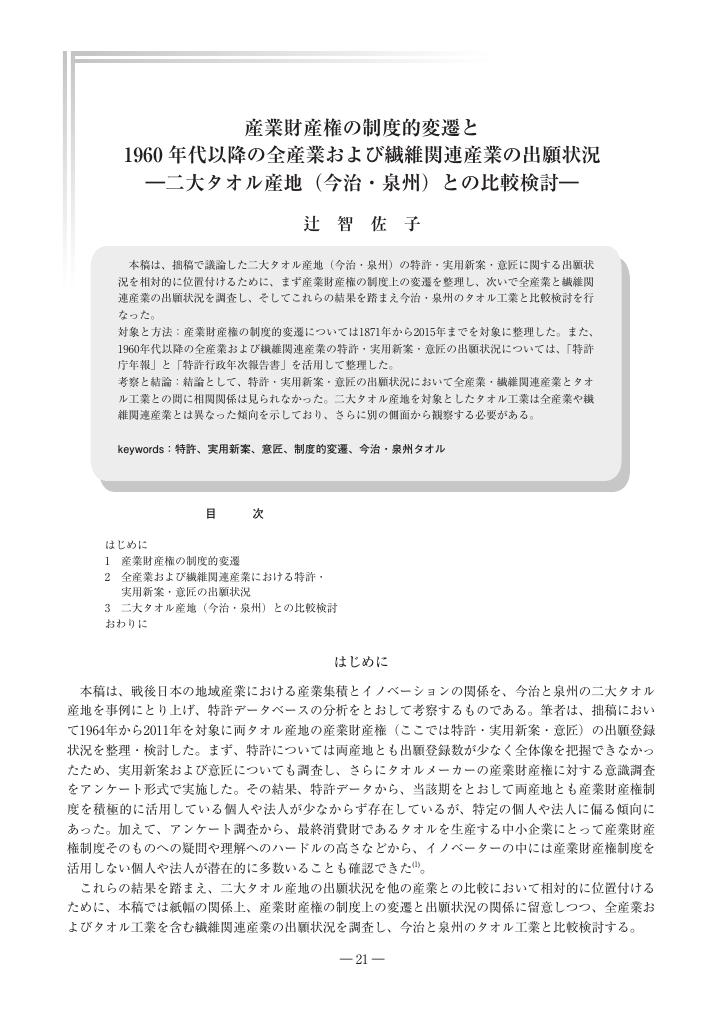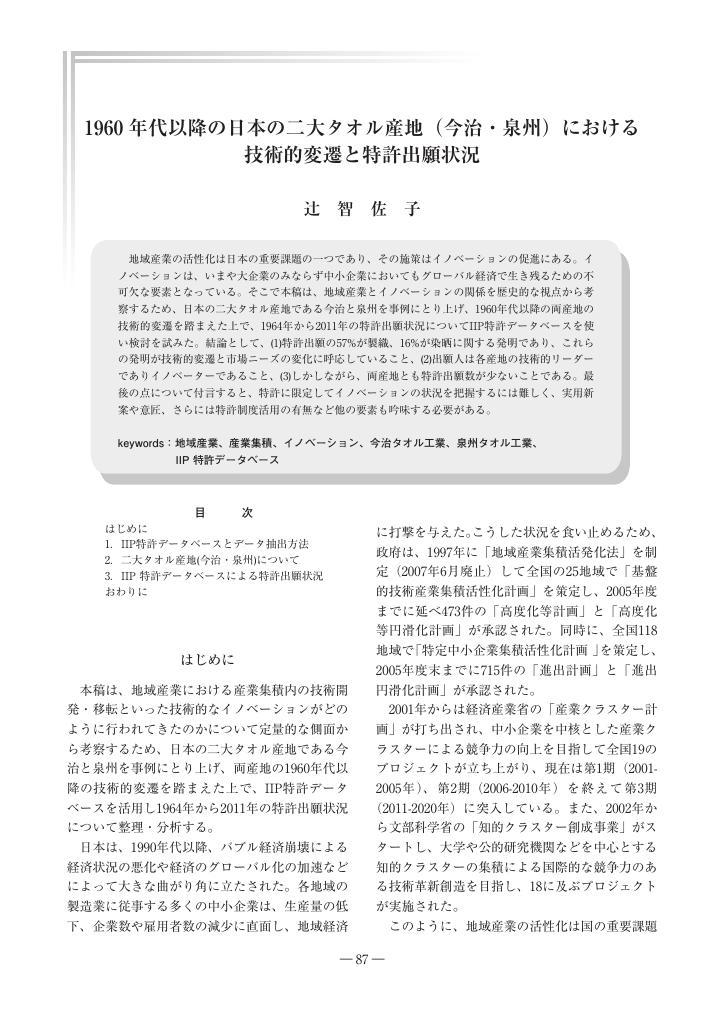4 0 0 0 OA 戦後日本の地域産業の発展と変容
- 著者
- 辻 智佐子
- 出版者
- 学校法人 東洋大学現代社会総合研究所
- 雑誌
- 現代社会研究 (ISSN:1348740X)
- 巻号頁・発行日
- vol.2020, no.18, pp.21-35, 2020 (Released:2021-04-15)
- 著者
- 辻 智佐子
- 出版者
- 学校法人 東洋大学現代社会総合研究所
- 雑誌
- 現代社会研究 (ISSN:1348740X)
- 巻号頁・発行日
- vol.2019, no.17, pp.35-52, 2019 (Released:2020-04-24)
2 0 0 0 IR 戦後の今治タオル工業の発展と近藤繊維工業 : 近藤憲司による革新的経営手法の導入
- 著者
- 辻 智佐子
- 出版者
- 城西大学経営学部
- 雑誌
- 城西大学経営紀要 (ISSN:18801536)
- 巻号頁・発行日
- vol.14, pp.31-61, 2018-03
本稿は,地域産業研究における事例研究として,戦後の松下労組結成を主導し,のちにタオルメーカーの二代目として采配を振るった近藤憲司をとり上げ,近藤は松下電器産業時代の経験を生かしながらいかなる経営手法よって一介のタオル工場を,今治地域を代表するタオルメーカーに成長させたのかを考察した。まず,当時のタオル業界の状況と近藤繊維工業について歴史的に整理し,近藤のタオル業界における貢献について述べた。次に,近藤の経営手法について,自社ブランドの構築,販売代理店制度の導入,積極的なマーケティング・宣伝活動の3つに絞って議論した。そして,近藤の経営理念と労使観について松下幸之助にも触れながら検討を加えた。This paper discussed Kenji Kondo as a case through which to study local industries.Kondo formed the Matsushita Electric Industrial Workers' Union and subsequently became the second president of a towel manufacturer, and this paper examined the type of management method Kondo adopted in order to rise from merely working at a towel factory to becoming a towel manufacturer representing the Imabari area, while alsomaking full use of his experience working at the Matsushita Electric Industrial Co., Ltd. First, this paper investigated the status of the towel industry when Kondo took office as the second president, as well as the history of Kontex Co., Ltd., and then described Kondo's contribution to the towelindustry.Next, this paper discussed Kondo's management method, focusing on the establishment of his company's brand, the introduction of a dealership system, and positive marketing and advertising activities.Finally, this paper examined Kondo's management philosophy and work ethic while also considering those of Konosuke Matsushita, the founder of the Matsushita Electric Industrial Co., Ltd.
1 0 0 0 OA 戦前期今治タオル工業の発展と公設試験研究機関における技術者の役割 ―菅原利鑅の事例から―
- 著者
- 辻 智佐子
- 出版者
- 経営史学会
- 雑誌
- 経営史学 (ISSN:03869113)
- 巻号頁・発行日
- vol.55, no.2, pp.3-26, 2020 (Released:2022-10-12)
This study examined how local public experiment and research institutes before World War II impacted the modernization of regional industries. It also analyzed engineers who flourished through the career and activities of Toshiharu Sugawara, the leader of the Industrial Training School of Ehime Prefecture and the Dyeing and Weaving Institute of Ehime Prefecture. To this end, this study focused on the towel industry in Imabari. The findings revealed that the establishment of a school system to cultivate engineers in the Meiji and Taisho Eras, the activities of low- and middle-ranking officials who studied at those schools, and the establishment of local public experiment and research institutes played an important role in the technological and human resource development of local light industries. As shown in the case of Toshiharu Sugawara, who became an official after studying spinning technology at Tokyo Higher Technical School, engineers engaged in technological and human resource development greatly contributed to the activities of local public experiment and research institutes before World War II. Because of the development and improvement of towel weaving machines and the cultivation of towel manufacturers by Toshiharu Sugawara, the Imabari area, which had held a subordinate position in towel manufacturing before World War II, became Japan’s top towel-producing district.
1 0 0 0 OA 1960年代以降の綿織物産地(播州・遠州東部)の特許・実用新案出願状況:二大タオル産地(今治・泉州)との比較検討―特許・実用新案出願状況に関する綿織物産地とタオル産地の比較分析―
- 著者
- 辻 智佐子
- 出版者
- 学校法人 東洋大学現代社会総合研究所
- 雑誌
- 現代社会研究 (ISSN:1348740X)
- 巻号頁・発行日
- vol.2021, no.19, pp.89-97, 2021 (Released:2022-05-18)
1 0 0 0 OA 1960年代以降の日本の二大タオル産地(今治・泉州)における技術的変遷と特許出願状況
- 著者
- 辻 智佐子
- 出版者
- 学校法人 東洋大学現代社会総合研究所
- 雑誌
- 現代社会研究 (ISSN:1348740X)
- 巻号頁・発行日
- vol.2018, no.16, pp.87-100, 2018 (Released:2019-10-31)
1 0 0 0 IR 政治参加の活性化とインターネットの関係性に関する一考察
本稿は,コミュニケーション手段の技術革新と選挙運動の高度化という観点から,第23回参議院議員通常選挙の候補者が展開したネット選挙運動や選挙をめぐるインターネット・コミュニケーションの動向のなかに,今後の政治参加に影響を与える要素を見出せるかについて考察した。まず,戦後日本の選挙制度の変遷を振り返り,そして2013年の公職選挙法改正のポイントを整理し,ついでアメリカにおけるネット選挙運動の事例から何が読み取れるのかについて先行研究に依拠しながら確認した上で,今回の選挙結果について分析を加えた。その結果,おもに次の4点を指摘した。一つに,ITマーケティング手法を選挙運動期間に導入することが得票に一定の効果をもたらす可能性があること,二つに,組織的な票獲得手段ではアプローチしにくい個人単位での投票行動を行うクラスターに対する選挙戦術として今後効果を上げ得ること,三つに,政党がITマーケティング手法を中長期的に活用してきた土壌に選挙運動期間において短期的にも活用するようになり,投票日に向けて票獲得を目指す選挙戦術の基本型が構築され始めた選挙であったこと,四つに,候補者のメッセージが有権者一人一人の興味関心などを引くことによって共感を形成し,中長期的な共感形成と短期的な共感形成の波を投票日に向けて最大化していくことが,今後政党や候補者がネット選挙戦術に期待する要素になること,である。 This paper examines, from the viewpoints of the technological innovation of the means of communication and the sophistication of election campaigns, whether it is possible for Internet election campaigns of some candidates for the 23rd Upper House Election and other forms of current internet communication to impact public political participation in the future. First, the paper reviews the history of changes in the election system of post-war Japan and outlines the key points of the current revision of the Public Office Election Law. Then, it introduces examples of Internet election campaigns in the United States and discusses their implications, referring to preceding studies. As the result of this review, the paper presents four important findings. (1)The introduction of the Internet marketing method used during the period of an election campaign can to some degree influence the number of votes obtained. (2)The Internet marketing method can engage individual voters who are difficult to approach through conventional organizational election campaign methods. (3)During the 23rd Upper House Election, political parties used the Internet marketing method in the short term, not just in the medium and long terms as they previously had; thereby, a new, basic form of election tactics to win votes began to be established. (4)In the future, political parties and candidates will expect their messages to draw attention from voters and be favorably shared by them, and will optimize the "waves" of the "feeling of being connected" between candidates and voters, both in short term, and the medium and long terms, in the days leading to the election.



